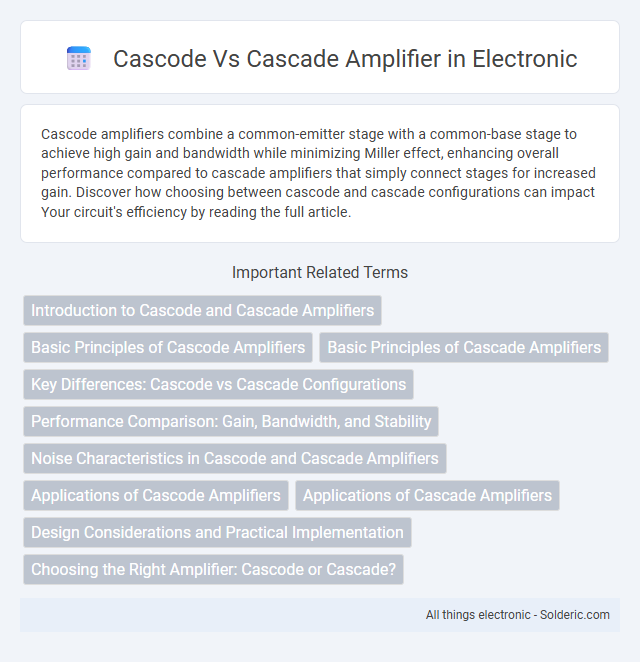Cascode amplifiers combine a common-emitter stage with a common-base stage to achieve high gain and bandwidth while minimizing Miller effect, enhancing overall performance compared to cascade amplifiers that simply connect stages for increased gain. Discover how choosing between cascode and cascade configurations can impact Your circuit's efficiency by reading the full article.
Comparison Table
| Feature | Cascode Amplifier | Cascade Amplifier |
|---|---|---|
| Configuration | Common-emitter/input stage followed by common-base stage | Two common-emitter amplifier stages connected in series |
| Gain | High gain with improved bandwidth | Higher gain but limited bandwidth |
| Bandwidth | Wide bandwidth due to reduced Miller effect | Lower bandwidth due to Miller capacitance multiplication |
| Input Impedance | Moderate input impedance | High input impedance |
| Output Impedance | High output impedance | Moderate output impedance |
| Noise Performance | Low noise, suitable for RF applications | Higher noise, less suited for high-frequency use |
| Complexity | More complex design | Simpler design |
| Applications | RF amplifiers, low noise stages, wideband amplifiers | Audio amplifiers, multi-stage voltage amplification |
Introduction to Cascode and Cascade Amplifiers
Cascode amplifiers combine a common-emitter stage with a common-base stage, offering high gain, increased bandwidth, and improved stability by minimizing Miller effect. Cascade amplifiers consist of two or more amplifying devices connected in series, enhancing overall gain but may introduce higher input-output loading and reduce bandwidth. Your choice between cascode and cascade configurations depends on the specific requirements for gain, frequency response, and noise performance in your electronic design.
Basic Principles of Cascode Amplifiers
Cascode amplifiers combine a common-emitter stage followed by a common-base stage, enhancing gain and bandwidth while reducing Miller capacitance effects. The low input capacitance and high output impedance of the cascode configuration improve high-frequency performance compared to cascade amplifiers. This arrangement provides better isolation between input and output, resulting in superior stability and increased gain-bandwidth product.
Basic Principles of Cascade Amplifiers
Cascade amplifiers consist of multiple single-stage amplifiers connected in series to achieve higher overall gain and bandwidth by multiplying the individual stage gains. Each stage operates independently, allowing for flexible design adjustments to optimize performance parameters such as input/output impedance and frequency response. This modular approach enhances signal amplification while maintaining stability and linearity across wide frequency ranges.
Key Differences: Cascode vs Cascade Configurations
Cascode amplifiers combine a common-emitter stage followed by a common-base stage, offering high gain, improved bandwidth, and reduced Miller effect, whereas cascade amplifiers connect multiple transistor stages in series to increase overall gain but suffer more from cumulative noise and bandwidth limitations. Cascode configuration excels in high-frequency applications due to its low input capacitance and stable gain, while cascade amplifiers are simpler and more flexible but have higher voltage headroom requirements and lower frequency response. The distinct structural arrangement in cascode results in enhanced linearity and isolation between input and output, contrasting with the direct stage-to-stage connection seen in cascades that can lead to signal degradation.
Performance Comparison: Gain, Bandwidth, and Stability
Cascode amplifiers provide higher gain and wider bandwidth compared to cascade amplifiers due to reduced Miller effect, enhancing frequency response and stability. The cascode configuration minimizes input-output capacitance interaction, resulting in improved high-frequency performance and better isolation between stages. Cascade amplifiers, while simpler, often suffer from limited bandwidth and reduced stability because the gain stages are directly connected, increasing parasitic capacitances and feedback effects.
Noise Characteristics in Cascode and Cascade Amplifiers
Cascode amplifiers exhibit superior noise performance compared to cascade amplifiers due to their reduced Miller effect and lower input capacitance, which minimizes noise gain and signal distortion. In contrast, cascade amplifiers tend to accumulate noise from each amplification stage, resulting in higher overall noise figures. Therefore, cascode configurations are preferred in low-noise applications, especially in high-frequency and RF circuits, where maintaining signal integrity is critical.
Applications of Cascode Amplifiers
Cascode amplifiers are widely used in RF and microwave circuits due to their high gain, improved bandwidth, and excellent input-output isolation. They are essential in low-noise amplifier (LNA) designs for communication systems, enhancing signal integrity and minimizing distortion. Cascode configurations also find applications in high-frequency oscillators and analog-to-digital converters where stability and linearity are critical.
Applications of Cascade Amplifiers
Cascade amplifiers are extensively used in radio frequency (RF) and communication systems for improved gain and bandwidth performance. Their configuration allows for higher overall voltage gain and better isolation between stages, making them ideal for intermediate frequency (IF) amplifiers in superheterodyne receivers. Cascade amplifiers also find applications in audio systems and instrumentation amplifiers, where low noise and stable gain are critical.
Design Considerations and Practical Implementation
Cascode amplifiers offer superior gain-bandwidth product and high input-output isolation, making them ideal for high-frequency applications, while cascade amplifiers provide increased gain through successive stages but may suffer from increased noise and reduced bandwidth. Design considerations for the cascode configuration include selecting transistors with matching frequency responses and ensuring proper biasing to prevent distortion, whereas cascade amplifiers require careful stage-by-stage impedance matching and noise management. Your choice between cascode and cascade amplifiers depends on application requirements related to bandwidth, gain, noise performance, and circuit complexity during practical implementation.
Choosing the Right Amplifier: Cascode or Cascade?
Choosing between a cascode and cascade amplifier depends on your specific requirements for gain, bandwidth, and noise performance. Cascode amplifiers offer high gain with improved bandwidth and reduced Miller effect, making them ideal for high-frequency applications, while cascade amplifiers provide increased overall gain through multi-stage amplification but may introduce more distortion and noise. Your decision should consider the trade-offs in linearity, stability, and complexity to optimize amplifier performance for your electronic circuit design.
Cascode vs Cascade amplifier Infographic

 solderic.com
solderic.com